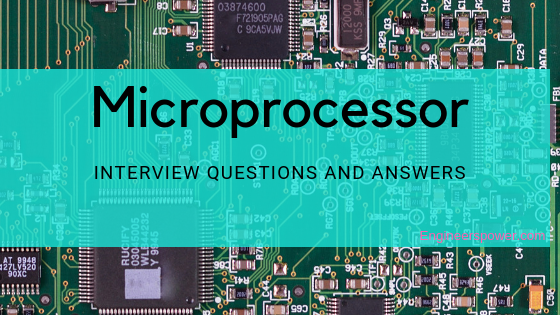Microprocessor Interview Questions and Answers
Q.1. Why the Z flag of 8085 microprocessor is not affected after execution of the instruction MOV D, B?
Answer: In 8085 microprocessor, zero flag is used to indicate the result of arithmetic or logic operation of ALU is zero or non zero. If the result is non zero, then Z flag will be zero (reset) and if the result is zero, then Z flag will be 1 (set). Here MOV (D, B) is not an ALU operation; hence zero flag is not affected.
Q.2. What is the requirement of DMA facility in microprocessor based systems?
Answer: The DMA data transfer will be useful to transfer large amount of data between memory and I/O device in a short time.
Q.3. Why the program counter in a 8085 microprocessor is a 16-bit register?
Answer: Program counter stores the address of next instruction to be executed. Since address is of 16 bit in 8085, so it has to be 16-bit.
Q.4. What is Assembler?
Answer: Assembler converts source code in to object code i.e. a program that translates symbolic code in to binary code.
Q.5. Why the output data lines of microprocessors and memories are usually tristated?
Answer: Using tristated buffer, more than one device can transmit information (data) over data bus by enabling only one device at a time.
Q.6. Which microprocessor is the first to include virtual memory in the Intel microprocessor family?
Answer: 80286; the Intel 80286 is a high performance 16 bit microprocessor. It has memory management capability, four level memory protection and support for virtual memory and operating system.
Q.7. In an Intel 8085A, what is the content of the instruction register (IR)?
Answer: IR contains the op-code for the instruction being executed.
Q.8. What is the content of the Program counter of an 8085 microprocessor?
Answer: Program counter contains the address of instruction to be executed next.
Q.9. What is LOADER?
Answer: A LOADER is a program which loads object code into system memory. It can accept programs in absolute or re-locatable format. If the actual address of instructions and data are given by the programmer, i.e. the program is in the absolute format, the loader simply loads the program into memory.
If programs are in re-locatable format, the specific memory addresses are assigned by the locator before the loader loads the program in to memory.
Q.10. What are the contents of interrupt vector table (IVT) OF 8086?
Answer: Interrupt vector table contains the starting of code segment value and instruction pointer values for the interrupt subroutine which is going to be served.
Q.11. What is R232 standard?
Answer: R232 is a complete standard. This means that the standard sets out to ensure compatibility between the host and peripheral systems by specifying:
- Common voltage and signal level.
- Common pin wiring configurations.
- A minimal amount of control information between the host and peripheral systems.
Q.12. Why data bus and address bus are multiplexed in 8085 microprocessor?
Answer: In 8085 lower order address bus and data bus are multiplexed to reduce the no of pins and demultiplexing is done using ALE pin, which is 1 then lower order byte work as address and when 0 work as data.
Q.13. What is handshaking?
Answer: The DMA transfer technique where one word data is transferred at a time is called handshaking.
Q.14. When handshake signal in a data transfer is transmitted?
Answer: Handshake signals are always transmitted before the data transfer.
Q.15. Which interfacing device is used for the generation of accurate time delay in a microcomputer system?
Answer: Intel – 8253 is programmable interval timer/counter used for generating accurate time delays and can be used for applications such as real time clock, an event counter, a square wave generator etc.
Q.16. How is charge stored in an EPROM cell?
Answer: EPROM (UV erasable programmable read only memory) is a special type of ROM that is programmable and yet is erasable under UV light. The EPROM device is programmed by forcing an electrical charge on a small piece of polysilicon material (called the floating gate) located in the memory cell. When this charge is present in the memory cell then it is programmed with logic ‘0’ and when charge is not present then it is programmed with logic ‘1’.
Q.17. What are RIM and SIM instructions of 8085 microprocessor?
Answer: SIM (set interrupt mask): This instruction make the interrupts as desired. It also sends out serial data through the SOD pin. For this instruction, command byte must be loaded in the accumulator.
RIM (Read interrupt mask): This instruction copies the state of the interrupts into the accumulator. It also reads the serial data through the SID pin.
Q.18. How the microprocessor communicates with a slow speed peripherals with the help of the ”Ready” signal?
Answer: In some applications, speed of input/output system is not compatible with the microprocessor timing. This means that it takes longer time to read/write data. In such situation, the microprocessor has to confirm whether a peripheral is ready to transfer data or not. If the “Ready” pin is high, the peripheral is ready otherwise 8085 enters WAIT STATE.
Q.19. What are the addressing modes of 8085 microprocessor?
Answer: 8085 has the following addressing modes –
- Immediate addressing mode.
- Register addressing mode.
- Direct addressing mode.
- Indirect addressing mode.
- Implicit addressing mode.
Q.20. What happens if the HLT instruction of an Intel 8085A microprocessor is executed?
Answer: On execution of HLT microprocessor finishes executing current instructions and halts any further execution and address and data buses are place in high impedance state (i.e. tristated).
You may also like to read:
- Network interview questions and answers.
- EMFT interview questions and answers.
- Electronic devices interview questions and answers.
- Control system interview questions and answers.
- Digital electronics interview questions and answers.
- Communication system interview questions and answers.
- Analog circuits interview questions and answers.
